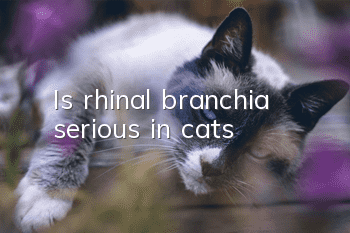Is rhinal branchia serious in cats?

Cat rhinoplasty is a viral infectious disease and a relatively serious disease. If it is not treated in time after the onset, it will lead to the death of the cat, especially the mortality rate of young cats. The disease is mainly caused by feline herpes virus type I. The incubation period is generally about 3 days. It can be transmitted directly through contact or secretions. Even cats that have recovered will detoxify the surrounding area through droplets and feces.
1. How to prevent nasal bronchitis in cats
Nasal bronchitis in cats is caused by herpes virus infection. Currently, the most effective ways to prevent nasal bronchitis in cats are as follows: First, vaccinations need to be scheduled on time. Usually, three shots of the combined vaccine are required for the first time, with an interval of 21 days between each shot. After that, one shot of the combined vaccine is needed every year to strengthen. Secondly, when the temperature changes greatly, it is necessary to provide food with high protein content and B complex vitamins to enhance the cat’s resistance. Furthermore, the cat’s living environment needs to be disinfected regularly to prevent the growth of fungi, bacteria, and viruses. Finally, if a cat in a multi-cat household is found to be infected, it needs to be isolated and treated in time.
2. How to diagnose and treat nasal branch in cats
The main diagnostic methods for nasal branch in cats are preliminary diagnosis and laboratory diagnosis. First, diagnosis can be made through symptoms. Cats infected with rhinophyma felis mainly manifest as listlessness, loss of appetite, abnormal body temperature, increased eye and nose secretions, mostly purulent secretions, accompanied by symptoms of coughing, sneezing, and tearing. Secondly, it can be diagnosed through the laboratory. Currently, PCR testing can be used to confirm whether it is a feline nasal branch. At the same time, routine blood tests can be used to determine the inflammation in the body. After a cat is diagnosed with feline rhinophyma, it needs to be treated with anti-viral, anti-inflammatory, cough and asthma measures in a timely manner.
- Why do cats like to follow people to the toilet?
- Ragdoll cats have diarrhea after being vaccinated? Is it normal?
- What smells can cats not smell?
- What should I do if my cat is too picky and won’t eat cat food?
- Why don't the catteries come to your door? It's really a helpless move.
- How much does a snowshoe cat cost and is it easy to raise? Snowshoe cat pictures | price | introduction
- What are the symptoms of cat fever?
- How can cat plague be transmitted?
- Can cats not be vaccinated?
- What are the advantages of cat food?



